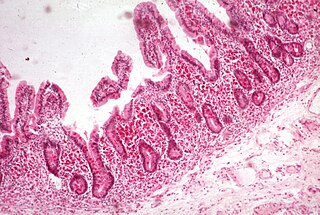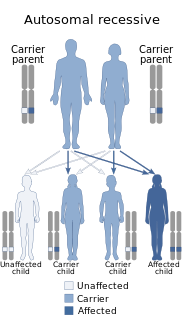Related Research Articles

Intrinsic factor (IF), cobalamin binding intrinsic factor, also known as gastric intrinsic factor (GIF), is a glycoprotein produced by the parietal cells (in humans) or chief cells (in rodents) of the stomach. It is necessary for the absorption of vitamin B12 later on in the distal ileum of the small intestine. In humans, the gastric intrinsic factor protein is encoded by the CBLIF gene. Haptocorrin (transcobalamin I) is another glycoprotein secreted by the salivary glands which binds to vitamin B12. Vitamin B12 is acid-sensitive and in binding to haptocorrin it can safely pass through the acidic stomach to the duodenum. In the less acidic environment of the small intestine, pancreatic enzymes digest the glycoprotein carrier and vitamin B12 can then bind to intrinsic factor. This new complex is then absorbed by the epithelial cells (enterocytes) of the ileum. Inside the cells, vitamin B12 dissociates once again and binds to another protein, transcobalamin II; the new complex can then exit the epithelial cells to be carried to the liver.

Pernicious anemia is a type of vitamin B12 deficiency anemia, a disease in which not enough red blood cells are produced due to the malabsorption of vitamin B12. Malabsorption in pernicious anemia results from the lack or loss of intrinsic factor needed for the absorption of vitamin B12. Anemia is defined as a condition in which the blood has a lower than normal amount of red blood cells or hemoglobin. The disease may come on slowly and insidiously.

Parietal cells (also known as oxyntic cells) are epithelial cells in the stomach that secrete hydrochloric acid (HCl) and intrinsic factor. These cells are located in the gastric glands found in the lining of the fundus and body regions of the stomach. They contain an extensive secretory network of canaliculi from which the HCl is secreted by active transport into the stomach. The enzyme hydrogen potassium ATPase (H+/K+ ATPase) is unique to the parietal cells and transports the H+ against a concentration gradient of about 3 million to 1, which is the steepest ion gradient formed in the human body. Parietal cells are primarily regulated via histamine, acetylcholine and gastrin signalling from both central and local modulators.

Malabsorption is a state arising from abnormality in absorption of food nutrients across the gastrointestinal (GI) tract. Impairment can be of single or multiple nutrients depending on the abnormality. This may lead to malnutrition and a variety of anaemias.
The Schilling test was a medical investigation used for patients with vitamin B12 (cobalamin) deficiency. The purpose of the test was to determine how well a patient is able to absorb B12 from their intestinal tract. The test is now considered obsolete and is rarely performed, and is no longer available at many medical centers. It is named for Robert F. Schilling.

Megaloblastic anemia is a type of macrocytic anemia. An anemia is a red blood cell defect that can lead to an undersupply of oxygen. Megaloblastic anemia results from inhibition of DNA synthesis during red blood cell production. When DNA synthesis is impaired, the cell cycle cannot progress from the G2 growth stage to the mitosis (M) stage. This leads to continuing cell growth without division, which presents as macrocytosis. Megaloblastic anemia has a rather slow onset, especially when compared to that of other anemias. The defect in red cell DNA synthesis is most often due to hypovitaminosis, specifically vitamin B12 deficiency or folate deficiency. Loss of micronutrients may also be a cause.

Atrophic gastritis is a process of chronic inflammation of the gastric mucosa of the stomach, leading to a loss of gastric glandular cells and their eventual replacement by intestinal and fibrous tissues. As a result, the stomach's secretion of essential substances such as hydrochloric acid, pepsin, and intrinsic factor is impaired, leading to digestive problems. The most common are vitamin B12 deficiency possibly leading to pernicious anemia; and malabsorption of iron, leading to iron deficiency anaemia. It can be caused by persistent infection with Helicobacter pylori, or can be autoimmune in origin. Those with autoimmune atrophic gastritis (Type A gastritis) are statistically more likely to develop gastric carcinoma, Hashimoto's thyroiditis, and achlorhydria.

Exocrine pancreatic insufficiency (EPI) is the inability to properly digest food due to a lack of digestive enzymes made by the pancreas. EPI is found in humans afflicted with cystic fibrosis and Shwachman–Diamond syndrome, and is common in dogs. EPI is caused by a progressive loss of the pancreatic cells that make digestive enzymes; loss of digestive enzymes leads to maldigestion and malabsorption of nutrients from normal digestive processes.

GATA-binding factor 1 or GATA-1 is the founding member of the GATA family of transcription factors. This protein is widely expressed throughout vertebrate species. In humans and mice, it is encoded by the GATA1 and Gata1 genes, respectively. These genes are located on the X chromosome in both species.
Transcobalamins are carrier proteins which bind cobalamin (B12).

Hydroxocobalamin, also known as vitamin B12a and hydroxycobalamin, is a vitamin found in food and used as a dietary supplement. As a supplement it is used to treat vitamin B12 deficiency including pernicious anemia. Other uses include treatment for cyanide poisoning, Leber's optic atrophy, and toxic amblyopia. It is given by injection into a muscle or vein.

Subacute combined degeneration of spinal cord, also known as myelosis funiculus, or funicular myelosis, also Lichtheim's disease, and Putnam-Dana syndrome, refers to degeneration of the posterior and lateral columns of the spinal cord as a result of vitamin B12 deficiency (most common), vitamin E deficiency, and copper deficiency. It is usually associated with pernicious anemia.
The term macrocytic is from Greek words meaning "large cell". A macrocytic class of anemia is an anemia in which the red blood cells (erythrocytes) are larger than their normal volume. The normal erythrocyte volume in humans is about 80 to 100 femtoliters. In metric terms the size is given in equivalent cubic micrometers. The condition of having erythrocytes which are too large, is called macrocytosis. In contrast, in microcytic anemia, the erythrocytes are smaller than normal.

Chylomicron retention disease is a disorder of fat absorption. It is associated with SAR1B. Mutations in SAR1B prevent the release of chylomicrons in the circulation which leads to nutritional and developmental problems. It is a rare autosomal recessive disorder with around 40 cases reported worldwide. Since the disease allele is recessive, parents usually do not show symptoms.

Haptocorrin also known as transcobalamin-1 (TC-1) or cobalophilin is a transcobalamin protein that in humans is encoded by the TCN1 gene. The essential function of haptocorrin is protection of the acid-sensitive vitamin B12 while it moves through the stomach.

Cubilin is a protein that in humans is encoded by the CUBN gene.

Amnionless is a protein that in humans is encoded by the AMN gene.

Imerslund–Gräsbeck syndrome is a rare autosomal recessive, familial form of vitamin B12 deficiency caused by malfunction of the "Cubam" receptor located in the terminal ileum. This receptor is composed of two proteins, amnionless (AMN), and cubilin. A defect in either of these protein components can cause this syndrome. This is a rare disease, with a prevalence about 1 in 200,000, and is usually seen in patients of European ancestry.
Olga Imerslund was a renowned Norwegian paediatrician, best known for her contribution to identification and naming of the Imerslund-Gräsbeck syndrome.

Hereditary folate malabsorption (HFM) is a rare autosomal recessive disorder caused by loss-of-function mutations in the proton-coupled folate transporter (PCFT) gene, resulting in systemic folate deficiency and impaired delivery of folate to the brain.
References
- ↑ Pedersen, Gitte Albinus; Chakraborty, Souvik; Stinhauser, Amie L.; Traub, Linton M.; Madsen, Mette (2010). "AMN directs endocytosis of the intrinsic factor-vitamin B(12) receptor cubam by engaging ARH or Dab2". Traffic. 11 (5): 706–20. doi:10.1111/j.1600-0854.2010.01042.x. PMC 2964065 . PMID 20088845.
- ↑ Quadros, Edward V. (2010). "Advances in the understanding of cobalamin assimilation and metabolism". British Journal of Haematology. 148 (2): 195–204. doi:10.1111/j.1365-2141.2009.07937.x. PMC 2809139 . PMID 19832808.
- ↑ Luder, A. S.; Tanner, S. M.; de la Chapelle, A.; Walter, J. H. (2008). "Amnionless (AMN) mutations in Imerslund-Gräsbeck syndrome may be associated with disturbed vitamin B(12) transport into the CNS". Journal of Inherited Metabolic Disease. 31: 493–496. doi:10.1007/s10545-007-0760-2. PMID 18181028. S2CID 207099766.
- ↑ Storm T, Emma F, Verroust PJ, Hertz JM, Nielsen R, Christensen EI (January 2011). "A patient with cubilin deficiency". N. Engl. J. Med. 364 (1): 89–91. doi:10.1056/NEJMc1009804. PMID 21208123.